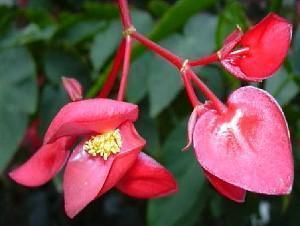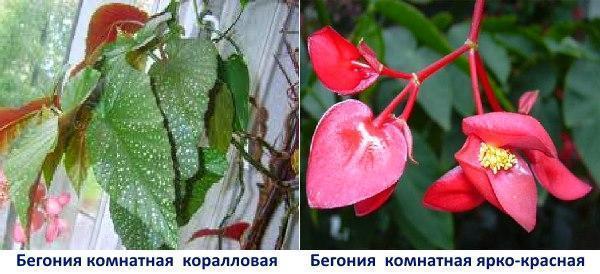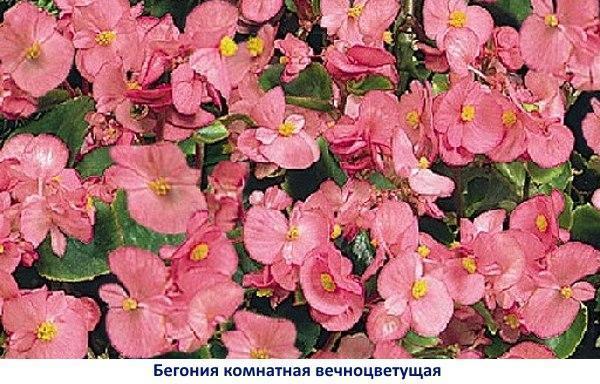Indoor begonia - care and cultivation
 The unpretentious plant - indoor begonia is of particular beauty and fame. This flower can leave few people indifferent. How to properly grow and care for room begonias, what are the popular types of room begonias, how to prepare the soil and properly transplant begonias, you can find out by reading this text.
The unpretentious plant - indoor begonia is of particular beauty and fame. This flower can leave few people indifferent. How to properly grow and care for room begonias, what are the popular types of room begonias, how to prepare the soil and properly transplant begonias, you can find out by reading this text.
The Begoniev family includes more than 800 plant species, native to Southeast Asia, Brazil, Africa and the island of Madagascar. In nature, the size of the begonia plant varies from 5 cm to 3 meters.
The many forms and varieties of this flower are striking in their diversity. Florists know that this flower is known not only for the variety of varieties and species, but also for the growing conditions. Begonia grown both outdoors and at home. Indoors, as a rule, a hybrid species of room begonia is planted.
Types of indoor begonias are:
- decorative blooming, eye-catching irresistible beauty of flowers;
- decorative deciduous, with a varied shape and color of leaves.
Popular types of flowers of indoor decorative blooming begonia
Bushy begonias:
- Coral begonia is a large plant with decorative leaves 10-15 cm long, having white spots and bright pink flowers;
- Indoor begonia bright red is a rather large plant with shiny, smooth ovoid leaves. The inflorescences of juicy red flowers are panicle-shaped.
- Indoor ever-flowering begonia is a low plant with round light green leaves, 5-6 cm long. Flowers blooming almost a whole year in white, red and pink.


Tuberous begonias:
- Begonia Elatior is a tall plant in the shape of a bush up to 35 cm high, decorative jagged green leaves and flowers of various colors reaching 4-5 cm in diameter. It blooms very luxuriantly and for a long time.
- Begonia Lorrain - plant height reaches 50 cm. Exotic rounded, dark green leaves, up to 8 cm long. Flowers are pink, red and white.

Popular types of indoor decorative leafy begonia plants
- royal begonia - has an unusually decorative leaf color that smoothly transitions from red to dark brown. The length of the leaves reaches 30 cm. One of the most popular decorative deciduous begonias;
- tiger begonia - up to 25 cm high, bush-shaped. The leaves are rather small, dark green, with spots of a light shade.

How to care for indoor begonia?
Caring for a room begonia is not difficult. This plant is not one of the capricious, but still it also needs some care.
Begonia belongs to light-loving plants, but direct sunlight is contraindicated for it, as it leads to leaf burns.
Begonia should be placed near the window, and if this is not possible, then shade it.
The maximum comfortable temperature for begonias in summer should not exceed 22-25about C, and in winter - 15-18aboutFROM.
Watering is of great importance for indoor begonias. Both dry soil and too wet soil are not suitable for this plant. For example, in spring and summer, home begonias should be watered as often as possible, but not flooded to prevent stagnant water. Determining when to water is not difficult. It occurs when the soil dries out to a depth of 1-2 cm.In addition, watering should be done with settled water.
Air humidity is also important for home begonia. Since this plant is native to the tropics and subtropics, it loves high humidity. If other plants can be provided with such a climate by spraying, then this is contraindicated for begonias.
If the begonia is sprayed, its leaves will be covered with spots. But there is a way out. It is enough to put the flower pot on moss, wet peat or place it in a shallow container with water.
Do not forget about plant nutrition. Begonia needs feeding 1-2 times a month. Fertilizers containing nitrogen are applied only to decorative leafy species, since nitrogen promotes leaf growth, but slows down flowering. But for decorative flowering fertilizers containing phosphorus are suitable.
It should be added that indoor begonia prefers fresh air, so the room in which it grows is periodically ventilated. At the same time, one should not forget that begonia is afraid of drafts, which can lead to its death.
You cannot take your eyes off the blooming begonia. She thanks her for taking care of her. Indoor begonia blooms for a long time, but not forever. Time passes, the flowers wither and crumble, the leaves fade and dry. The time for rest and sleep comes. Now begonia should be watered less often, and the air temperature should be provided cooler - up to 14-16aboutC. Cut off all dried parts of the plant and prepare for transplantation.
How to transplant indoor begonia correctly?
You can prepare the soil for begonia yourself. This plant prefers a light substrate. It is prepared from a mixture of leaf and turf soil, rotted humus, sand and peat. It is important to pay attention to the fact that the leafy earth should be slightly more than half of the total volume of the pot.
Indoor begonia does not require frequent transplantation, but if the roots are already cramped, then transplantation is necessary. Usually, begonias are transplanted in the month of March.
Carefully remove the flower from the pot, clean the roots of old soil and place them for a while in a solution of potassium permanganate. Potassium permanganate helps protect the roots from fungal diseases, to which indoor begonia is prone. Then all damaged roots are cut off and placed in a new container with earth.
When transplanting a plant, do not fill the pot to the top. The soil is added later, as the roots grow back. After transplanting, indoor begonia requires increased attention and care. In the first month, watering should be increased and carefully protected from direct sunlight.
Diseases and pests of room begonia
The indoor begonia plant is not resistant to fungal diseases. Noticing that the plant begins to get sick, the affected areas should be removed. Begonia can also be affected by pests. Her enemies are aphids and spider mites. At an early stage of the disease, it is recommended to rinse the plant in a soapy solution. And for serious treatment, it will be enough to treat it with a fungicidal preparation, in the way indicated in the instructions for use.